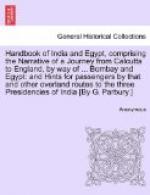Here too comes the itinerant fruit-seller, very often a woman, who hawks fruit of all kinds from the superior mango to the acid “karaunda” of the Ghats. For the sale of country-mangoes a place of vantage is required; so she takes up a strong position on the roadside or on the doorstep of a house and sets to work to pick out her best fruit and place it on the top of her basket. She is generally a Deccani, either Musulman or Hindu, varying in age from 20 to 40 and is fully capable of conciliating the Lord of the Bombay pavements, when he somewhat roughly commands her to move on. “Jemadar Saheb” she calls him; and if this flattery is insufficient she offers one of her ripest mangoes with a glance that he cannot resist. It is too much for the sepoy: he smiles and tramps off, and she holds her position undisturbed. If she be a Hindu, you will probably notice the bright-red mark on her forehead, joining brow to brow, or, in the words of a Persian poet, uniting two Parthian or Tartar bows into Kama’s Long-bow. The male mango-hawker is a Deccan Hindu or Musulman gardener who purchases a stock of showy inferior fruit from the wholesale dealers. After the mango season is over he becomes a vendor of Poona figs or Nagpur oranges. He is often a small, dark, muscular man who began life as a day-labourer in the highly-cultivated fields of the Deccan and has journeyed to the city with his modest savings tightly tied up in his waist-cloth in the hope of eventually cutting as big a figure in the village home as does his friend Arjuna, who some years ago returned to his village as a capitalist and is even now the bosom-friend of the Patel.
[Illustration: The Coffee-seller.]
The itinerant coffee-vendor is a characteristic feature of the Musulman quarters of Bombay. Of Arab or Egyptian origin, this coffee-trade immediately proved attractive to the Musulman public and, inasmuch as it requires little stock or capital, has been a boon to many a poor Mahomedan anxious to turn an honest penny. The “kahwe-wala” has no cry and yet manages to proclaim his presence by sounds which are audible in the inmost darkness of the chals. He is the beetle of the pedlar tribe. He does not sing, he does not cry—he stridulates. Carrying in his hand a large number of small coffee-cups, fitted one within another, he strikes them together like a string of castanets, while in the left hand he bears a portable stove-like article on which rests his tin or copper kettle.




